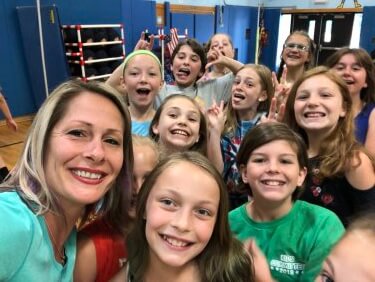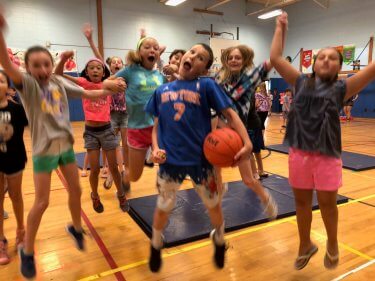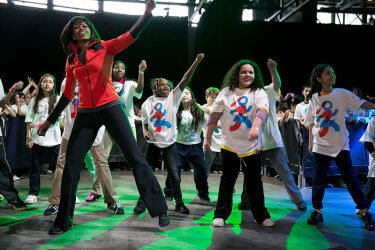Have you every observed a great activity or lesson and thought, “Wow, what a great idea! My students would LOVE that!”? Then, shortly after, you hear that annoying inner voice in your head whisper “Too bad I’m not creative.” Well, it is time to challenge that inner voice to stop thinking so negatively and work with you here! Seriously, if that inner voice was one of my friends we would not be spending a whole lot of quality time together!
What makes a “creative person”? Is it a gift from God? Are you born that way? Is it a learned behavior? Is it a sign of genius or a sign of madness!?
Creativity is a phenomenon whereby something new and somehow valuable is formed.That being said, everyone can be creative! We teach our students that belief in themselves is the first step to achieving any goal. Let’s take our own advice and believe we can be just as creative as that teacher or speaker who amazed us! By changing our mindset, we can foster creativity!
Here are fifteen ways that I find help me to get my creative juices flowing. Try one (or all) and see where your creativity takes you.

- Play with Your Children
Play is not just essential for kids; it fuels our imagination, stimulates our minds, and boosts our creativity. Additionally, it helps us relax, relieves stress, improves our mood and increases our energy. Go on adventures with your children. Don’t have children? Borrow them! Nieces, nephews, and neighbors are great for that. When time and funding permit, I allow each one of my three children to have a turn picking an “adventure” of their choice. Whatever they choose, we do as a family with the joyful abandon of childhood.
Somedays I give them parameters and other days I let their imagination run wide (until recently when my son suggested hang-gliding). Since then, I have had to discuss limitations with him. Allowing children to choose their own adventure exposes you to new ideas and stimulates your creativity and imagination, as well as your children. A win-win for all! Adventures do not have to cost money. Challenge your children to come up with adventures that are free and fun. You will be amazed at how many new things you and your children will be exposed to. Head to a local park and go on a treasure hunt. Set up forts and have a water balloon fight, build a ninja warrior obstacle course, make mud pies, build boats and see whose floats. Play pretend games and get silly and wacky with your children. This allows us to look through children’s eyes and think outside the box. This will help you to create interesting and exciting lessons for your students.
- Watch and Observe the Age Group You Teach
What are they into? What are their hobbies? What is the newest craze the students are all discussing and excited about? Whenever possible, I add their interests into my lessons to spice things up and keep the students engaged and enthusiastic about learning.

- Be Curious About Everything
You never know when random, unrelated ideas might come together to form a new idea. I am always amazed at how many ideas I get for lessons from topics that have NOTHING to do with Physical Education! As Walt Disney said, “We keep moving forward, opening new doors, and doing new things, because we’re curious and curiosity keeps leading us down new paths.”
- Feeling Stale or Stuck? Try Something New
Every summer break I try to learn something new. It could be something I have always wanted to learn or something completely out of my comfort zone. I have tried things like learning piano, ballroom dancing, and stained glass. This breaks up the monotonous routine of the day and gives me a fresh perspective. Trying new things forces us to be innovative and to think. Seeing things in a new light improves our creativity.
- Be an Investigator: Investigate Alternatives to Problems
Do you have a subject, topic, or activity you would love to try with your students but do not know how to get started? Are you lacking funds or materials? Think outside the box. Can you make the materials yourself? Can you use any preexisting materials in place of other materials needed? Do any of your co-workers have materials you can borrow? Brainstorm solutions with co-workers. Even talk it over with a friend who has no connection to the educational profession. Seek their suggestions and input. It may not be the final idea you decide upon, but you may build other ideas off of their suggestions or see the problem in a new light. In addition, ask kids. They are a fabulous resource! You will be amazed at their creativity and helpful spin they place on the problem. Their ideas for solutions will cause you to pause, be mesmerized by the genius in simplicity, or at least give you a great chuckle. Combine ideas when possible. Embrace obstacles and see them as what they are: a creative opportunity!

- Explore Pinterest
Never been on Pinterest? What are you waiting for? Pinterest is a social network which allows you to share content and interests. You can attach images from other member’s websites or boards. It is a great way to compile content, connect with other teachers, and organize and save your ideas. Be prepared for the ideas to flow!
- Hack My Life sites
If you want to walk away with a fresh perspective or spin on daily life, just browse the web for “hack my life” ideas! These sites offer useful hacks in terms of organizing your home or classroom, making or distributing materials, creating review games, lesson ideas, and just about anything else you have an interest in!
- Browse Catalogs/Window Shop
I love to browse all types of catalogs, such as PE equipment catalogs, Oriental Trading catalogs, and art supply store catalogs. I walk the aisles in toy stores, dollar stores, bargain stores, Walmart, A.C. Moore, Michaels, Joann, etc. I look everywhere I can for inspiration and I look at different items and think about how I can use or manipulate the item or game to better teach my subject area. Just recently, I made awesome shields and fencing swords from inexpensive objects found at discount stores.
- Beg, Borrow and Steal
Begging, borrowing, and stealing are three words with which teachers are very familiar. Henry Ford said, “I invented nothing new. I simply assembled the discoveries of other men behind whom were centuries of work.” In Kirby Ferguson’s TED talk he argues that the basic elements of all creativity can be boiled down to “copy, transform, and combine.” Not many ideas just arrive out of thin air; most come from combining or remixing already existing ideas. However, there is a BIG DIFFERENCE between borrowing and plagiarizing. Borrowing an idea means you were inspired by it, you pay homage to it, you appreciate the effort and work that went into the concept, and you give credit to the original creator. Plagiarizing means you are passing it off as your own idea.
- Surf the Web
When time permits, I love to surf the web and explore what other educators are doing in their classroom. I have come across some great sources of inspiration while browsing YouTube, Twitter, Facebook, while viewing NYS AHPERD’s “Get Moving NY” videos, browsing Teachers Pay Teachers site, etc. There is a wealth of inspiration at your fingertips from the web. One of my favorite things to do is spend time in the Teachers Pay Teachers website exploring subject areas other than my own. I love to see what other educators are teaching in their classroom and see how I can integrate it with my own teaching style and ideas. What techniques, skills, or games are they using to drive points home to our students? Is there anything I can pull from the information to help further my own students’ progress? This is a creative process that I’m convinced has aided me as an educator. It has improved my students’ ability to problem solve and think critically and has led to the improvement of other higher-order thinking skills.

- Attend Conferences and Professional Organizations Meetings
Attending conferences & meetings, such as SHAPE America & NYS AHPERD are a great way to expose yourself to new ideas, skills, and concepts and it recharges your creative batteries. It will keep you up to date on the newest trends and technology. It will build your professional network and help you strategize and plan for the future. It is also a great way to see who is breaking new ground in PE.
- Set Aside Time to Create
Schedule a time during the week that you block out for the sole purpose of being creative. My principal plans a time once every few months for all special-area teachers to collaborate on new ideas. I love it!
- Socialize with People Different Than You
Take time getting to know them. Explore how they see the world. Many times, it will enlighten and inspire you to see something through a new lens.
- Go Out in Nature
Take a hike. Get a breath of fresh air. Stop and listen to the birds, smell the flowers, feel the grass on your feet, and put away the smartphone and electronics! Just let your mind rest. Sometimes this is all I need to overcome a creative block.
- Be Weird
Use ordinary objects in extraordinary ways. Use props. Have a box of strange things close at hand. You will be surprised at how often you use them! A farting pig, a flying pig, shark mask, angel wings, superhero cape, a lemur, are just some of the items I keep nearby. Make the familiar strange, or the strange familiar. Sometimes all it takes to spark creativity is a weird, different, or unusual spin on things.

Beth is an inspiration to both young and old alike. To know her is to love her. Now I understand how she works her magic. Great article coach!